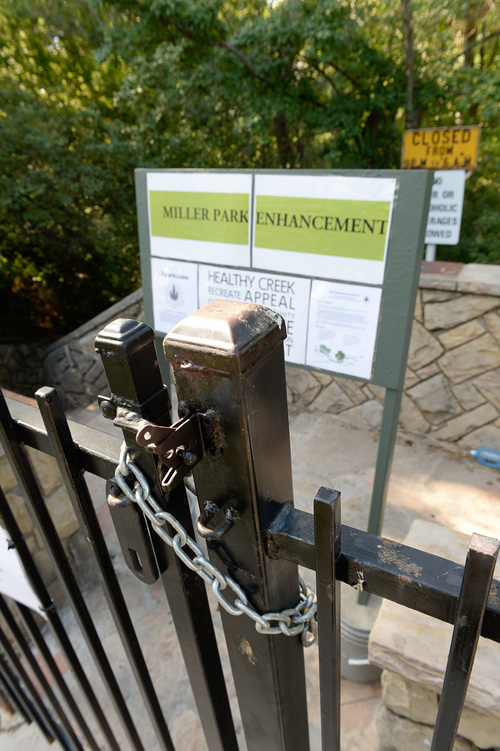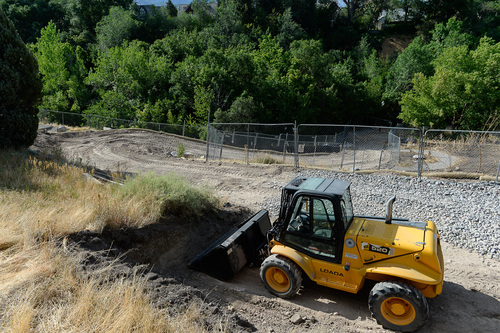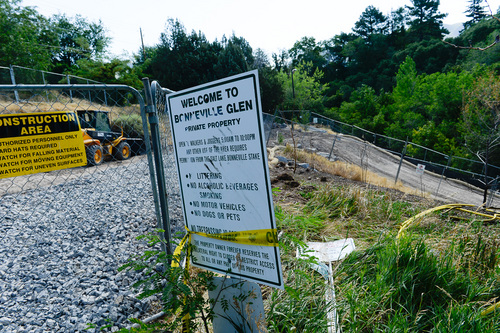This is an archived article that was published on sltrib.com in 2014, and information in the article may be outdated. It is provided only for personal research purposes and may not be reprinted.
The owls are screeching in Salt Lake City's east-side Miller Park Bird Refuge — and so are the backhoes.
After months of consulting and clashing with neighbors and the Great Salt Lake Audubon over restoration plans for the park straddling Red Butte Creek, the city has begun work on a project that will thin out non-native trees, fortify stream banks and improve trails.
But city officials have taken note of the discord and have amended their plan. Crews will remove fewer trees in the short term in what is now seen as a project with two distinct phases.
The 8.75-acre park between 1500 East and 1700 East at about 1000 South will be closed until mid-November. During the next three to four months, workers will remove 194 non-native trees, down from the earlier goal of 275, said Emy Maloutas, the city's open-space lands program manager.
"We wanted to respond to what we were hearing from residents," she said. "This is a unique opportunity to achieve so many benefits for the community and environment."
A second phase will take shape in five to eight years after native vegetation planted this season has had a chance to grow, she explained. At that time, another 145 non-native trees would be removed, according to the plan.
Although the two-phase endeavor would remove more trees than the original proposal, it would have less impact on neighbors and wildlife, Maloutas said.
Phase one's funding, $765,000, comes from Chevron through the Utah Division of Water Quality as mitigation for damage done by the energy company's ruptured pipeline, which in June 2010 sent oil down Red Butte Creek.
Phase two has not been funded, said City Council Chairman Charlie Luke, whose District 6 encompasses the park. "If five to eight years from now we want to go forward with phase two, the council will have to fund it."
Nonetheless, it looks to be a noisy summer and fall for residents surrounding the refuge, said Lisa Long, whose property abuts the park.
"They are scaring the birds," she said of the work that recently began. "The birds were flushing out because of the loud machinery."
In April, the Great Salt Lake Audubon warned the city that tree cutting should not take place during the April-through-August nesting season. The group's acting president, Heather Dove, said disrupting nests during that time frame would run afoul of the federal Migratory Bird Treaty Act.
Western screech owls, American kestrels, passerine songbirds and other migratory fowl use the refuge for nesting.
It's unclear, however, whether noise qualifies as disrupting nesting activities.
The project seeks to remove three non-native species along the creek: Siberian elm, tree of heaven and black locust.
A number of residents near the park say they like the black locust — a species brought to Utah by early pioneers.
"I love the black locust along my fence," Long said. "I'm not sure what's going to happen to them."
It looks like Long and her neighbors won't lose a lot of their favorite trees — for now. Most of the phase one work will be near the stream bank rather than up-slope near property lines.
Dove said she is glad the city has amended its plan and is beginning work toward the end of nesting season rather than in April. In addition, she said, the two-phase approach will have less impact on wildlife.
"The city has listened," Dove said. "And I hope they will remember this lesson and not do the next phase of tree thinning during nesting season."
In coming weeks, Maloutas said, the city will lead residents on tours of the streambed and revegetation work.
"We want people to witness this restoration process," she said. "Natural habitat areas [within the city] are few and far between."









